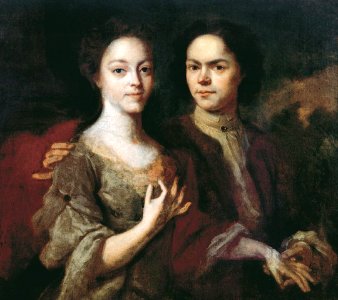Soon after returning from abroad, matveyev married the daughter of a blacksmith master of the chancellery of buildings, irina stepanovna antropova, a cousin of his student alexei antropov. At that time, he was twenty-seven years old, and she was fourteen. It was then that the artist’s best, most famous and controversial work, “self-portrait with his wife,” was created. Despite the master’s busy schedule, the young family lived in poverty. Only when they already had three children — evdokia, ivan and maria — did the artist manage to buy a house in 1734, and even then he petitioned for the issuance of his withheld salary and even indicated that he “had nothing to introduce to the christian faith” for his newborn daughter. The youngest son, born in 1736, studied painting at the academy, then served with the prosecutor general, prince vyazemsky, and received a noble rank. He preserved and presented to the imperial academy of arts in 1808 a portrait of his parents, his father's most remarkable work. This work is the only painting of this genre in russian art of the first half of the 18th century. The time for reflection on the personality of an artist had not yet come in russia, and only an artist who had been educated abroad for 11 years and had just returned to his homeland could have come up with such an idea. It arose - and remained unfinished, as apparently happened with matveyev's work. This is the first self-portrait in russian painting, evidence of self-awareness and high self-esteem of his role as an artist, a creator in a country and environment where an artist was practically no different from a craftsman. This is the first work of chamber lyrical painting, speaking of love with unprecedented ardor, trepidation and chastity. For the first time, a russian artist decided to draw attention to his person and so openly declare his feelings. For the first time, the subject of the image becomes a tender and loving relationship between spouses. A naively touching pride in himself, his young wife, his art, the very possibility of painting like this permeates this creation of the artist. There was much that was bad and terrible in the era of peter the great, this portrait is a symbol of all the good that it brought with it. In "self-portrait with his wife" matveyev embodied, in a way, a vision of the significance of the artist's personality, his dignity, his place in life. Before us is a man of the era of peter the great, a witness of the cultural rise of russia, aware of his need and proud of it. The spouses are depicted from the waist up, against the background of a cloudy sky. They seem to be strolling, while their faces are turned towards the viewer, as if, having noticed him, they stopped for a moment to greet him. Coming from the middle classes of society, they are dressed in exquisite and expensive dresses, according to court fashion, but there is no smug or arrogant expression on their faces at all. On the contrary, they are filled with noble simplicity and the dignity that is characteristic of people who have achieved their position through their own talents and labors. Irina matveeva captivates with her youthful freshness and delicate blush. Her husband's face is remarkable for its bold, energetic, intelligent expression, which seems to embody the bright sides of the peter the great era. After the artist's death, his widow remarried, passing on to her new husband all of matveyev's wealth. That is why the artist's youngest son, vasily, was left with this unfinished double portrait from his father, which he donated to the academy of arts shortly before his death in 1808. The inscription on the back of the painting, which has survived to this day, reads: "matveyev, andrei, the first russian painter and his wife. Painted by the artist himself. ". Object Type: painting. Date: 1729. Dimensions: 75.5 × 90.5 cm (29.7 × 35.6 in). Medium: oil on canvas. Collection: Russian Museum. Andrei Matveev - Selfportrait with wife
Loading...
